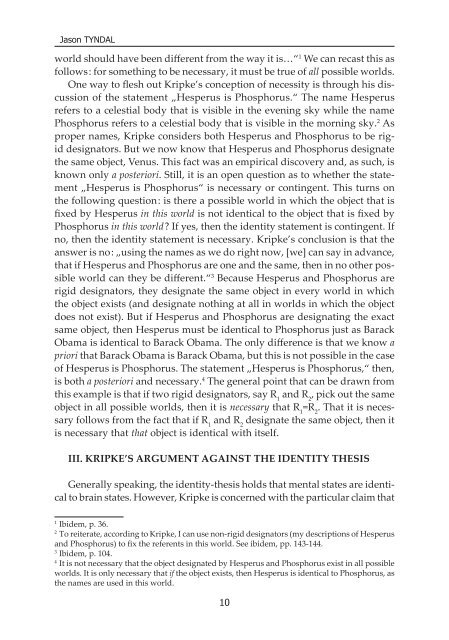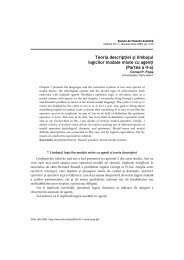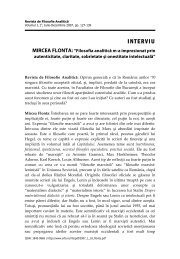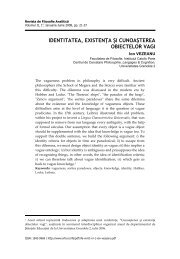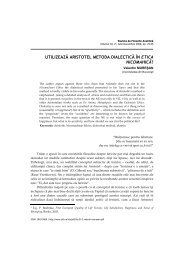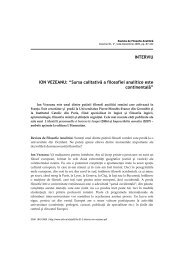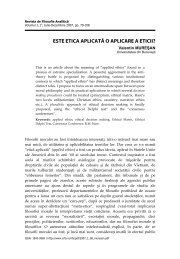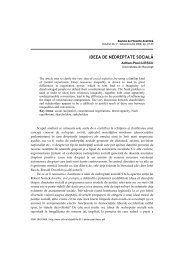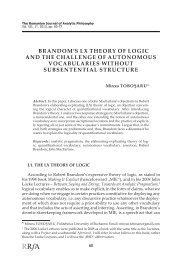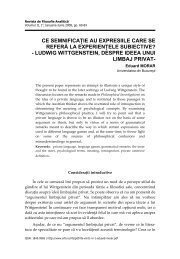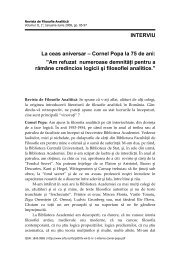AN ANALYSIS OF KRIpKE'S ARguMENT AgAINST THE IDENTITY ...
AN ANALYSIS OF KRIpKE'S ARguMENT AgAINST THE IDENTITY ...
AN ANALYSIS OF KRIpKE'S ARguMENT AgAINST THE IDENTITY ...
You also want an ePaper? Increase the reach of your titles
YUMPU automatically turns print PDFs into web optimized ePapers that Google loves.
Jason TYNDAL<br />
world should have been different from the way it is…“ 1 We can recast this as<br />
follows : for something to be necessary, it must be true of all possible worlds.<br />
One way to flesh out Kripke’s conception of necessity is through his discussion<br />
of the statement „Hesperus is Phosphorus.“ The name Hesperus<br />
refers to a celestial body that is visible in the evening sky while the name<br />
Phosphorus refers to a celestial body that is visible in the morning sky. 2 As<br />
proper names, Kripke considers both Hesperus and Phosphorus to be rigid<br />
designators. But we now know that Hesperus and Phosphorus designate<br />
the same object, Venus. This fact was an empirical discovery and, as such, is<br />
known only a posteriori. Still, it is an open question as to whether the statement<br />
„Hesperus is Phosphorus“ is necessary or contingent. This turns on<br />
the following question : is there a possible world in which the object that is<br />
fixed by Hesperus in this world is not identical to the object that is fixed by<br />
Phosphorus in this world If yes, then the identity statement is contingent. If<br />
no, then the identity statement is necessary. Kripke’s conclusion is that the<br />
answer is no : „using the names as we do right now, [we] can say in advance,<br />
that if Hesperus and Phosphorus are one and the same, then in no other possible<br />
world can they be different.“ 3 Because Hesperus and Phosphorus are<br />
rigid designators, they designate the same object in every world in which<br />
the object exists (and designate nothing at all in worlds in which the object<br />
does not exist). But if Hesperus and Phosphorus are designating the exact<br />
same object, then Hesperus must be identical to Phosphorus just as Barack<br />
Obama is identical to Barack Obama. The only difference is that we know a<br />
priori that Barack Obama is Barack Obama, but this is not possible in the case<br />
of Hesperus is Phosphorus. The statement „Hesperus is Phosphorus,“ then,<br />
is both a posteriori and necessary. 4 The general point that can be drawn from<br />
this example is that if two rigid designators, say R 1<br />
and R 2<br />
, pick out the same<br />
object in all possible worlds, then it is necessary that R 1<br />
=R 2<br />
. That it is necessary<br />
follows from the fact that if R 1<br />
and R 2<br />
designate the same object, then it<br />
is necessary that that object is identical with itself.<br />
III. KRIPKE’S ARGUMENT AGAINST <strong>THE</strong> <strong>IDENTITY</strong> <strong>THE</strong>SIS<br />
Generally speaking, the identity‐thesis holds that mental states are identical<br />
to brain states. However, Kripke is concerned with the particular claim that<br />
1<br />
Ibidem, p. 36.<br />
2<br />
To reiterate, according to Kripke, I can use non‐rigid designators (my descriptions of Hesperus<br />
and Phosphorus) to fix the referents in this world. See ibidem, pp. 143‐144.<br />
3<br />
Ibidem, p. 104.<br />
4<br />
It is not necessary that the object designated by Hesperus and Phosphorus exist in all possible<br />
worlds. It is only necessary that if the object exists, then Hesperus is identical to Phosphorus, as<br />
the names are used in this world.<br />
10


